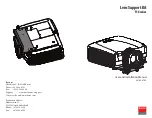
GLOSSARY
A-4
CP2000-X User Manual
020-100031-01 Rev. 1 (03-2009)
The sharpness of a display from a video source.
A type of rear-projection screen which spreads the light striking it. Screen gain is
typically less than 1 but audience viewing angles are increased. Rarely used in
cinema.
Professional public presentation of theatrical content by electronic means,
particularly emphasizing projectors such as the
CP2000
whose image source is
digital data. Also known as d-cinema and (rarely) e-cinema.
Also known as digital scaling. The process of averaging pixel information when
scaling (resizing) an image up or down. When reducing the size of an image, adjacent
pixels are averaged to create fewer pixels. When increasing the size of an image,
additional pixels are created by averaging together adjacent pixels in the original
smaller image.
The maximum frequency of the pixel clock.
The Enhanced Extended Display Identification Data standard, established by VESA,
enables properties (such as resolution) of a display device to be detected by the
display card in a controlling device such as a PC. The PC, in turn, can then output in
a matching format to fill the display. Some sources used with the projector are VESA
E-EDID reported.
Emergency stop of the presentation due to equipment failure, a commotion in the
audience, or any trigger from the theatre’s life safety system that could require
stopping the show, raising the house lights, and enabling a PA announcement.
The intensity of visible light per square foot.
The luminance (brightness) which results from one foot-candle of illumination falling
on a perfectly diffuse surface. 1 fL = 3.423 candela per square meter (cd/m
2
). Note
that SMPTE RP 98 calls for theatre screen luminance of
12
to 22 fL; 16 +/- 2 fL (55
+/- 7 cd/m
2
) is the open gate target according to SMPTE 196M. For cinema
applications,
xenon lamp
wattage is approximated to achieve this level using 12 W/ft
2
x (screen height squared) or 5 W/ft
2
of total ‘scope image area, for matte screens and
typical lenses.
The frequency at which complete images are generated. For non-interlaced signals,
the frame rate is identical to the vertical frequency. For interlaced signals, the frame
rate (also known as field rate) is one half of vertical frequency.
The ability of a screen to direct incident light to an audience. A flat matte white wall
has a gain of approximately 1. Screens with gain less than 1 attenuate incident light;
screens with gain more than 1 direct more incident light to the audience but have a
narrow viewing angle. For example: An image reflecting off a 10 gain screen appears
10 times brighter than it would if reflected off a matte white wall. Curved screens
usually have larger gain than flat screens.
Grass Valley Group (formerly part of Tektronix). More specifically, the .gvg file
format used for compressed video, audio, and timecode stream transfer in the Profile
Detail
Diffused
Screen
Digital Cinema
Digital Interpolation
Dot
Clock
E-EDID
E-stop
Foot-candle
Footlambert
Frame Rate
Gain
or Screen Gain
GVG
Содержание CP2000-X
Страница 1: ...CP2000 X U S E R M A N U A L 020 100031 01...
Страница 2: ......
Страница 42: ......
Страница 102: ......
Страница 112: ......
Страница 130: ......
Страница 135: ...SPECIFICATIONS CP2000 X User Manual 8 5 020 100031 01 Rev 1 03 2009...
Страница 160: ......
















































